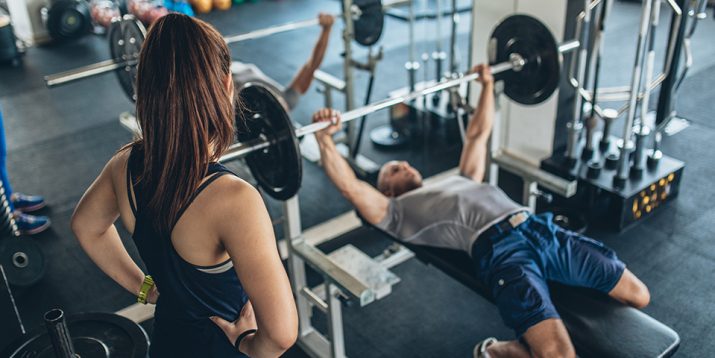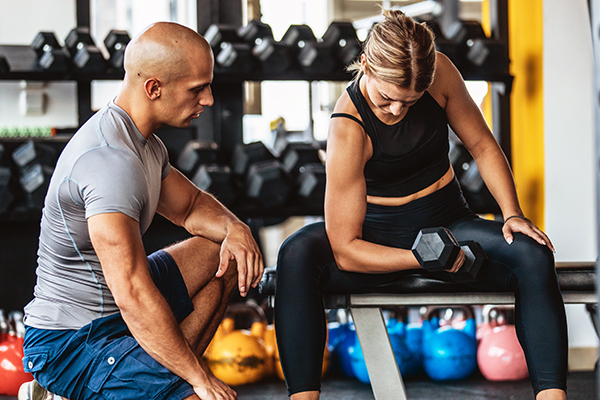What Muscle Groups to Work Out Together

Have you ever wondered why so many strength-training programs divide up the major muscle groups in similar ways?
Chest and shoulders, back and arms, and legs and core are common combos.
While this is far from the only way to tackle resistance training (and it may not even be the best way), teaming up major muscle groups is a time-efficient approach that can help max out fatigue since you pair up muscles that overlap or work together, says Lance Goyke, M.S., C.S.C.S.
Read on to learn what muscle groups to work out together, the best muscle group combinations, and how to structure a strength training plan for your individual goals.
Major Muscle Groups

These are the major muscle groups and common exercises that target them:
- chest (including pectorals and serratus anterior): flat bench press, push-ups, and chest dips.
- back (including lats and rhomboids): deadlifts, bent-over row, and lat pulldowns.
- arms (including biceps and triceps): triceps extensions, biceps curls, and skull crushers.
- abdominals: planks, bicycle crunches, and dead bugs.
- legs (including glutes, hamstrings, calves, and quadriceps): squats, lunges, and step-ups.
- shoulders (including traps and deltoids): overhead presses, push presses, and front raises.
There are two main approaches to determining what muscle groups to work out together.
“The classic body part split pairs muscles that typically work together to perform a key movement (e.g., chest and tris in pushing motions, back and biceps in pulling motions) and non-competing muscle groups (e.g., legs and shoulders),” says Trevor Thieme, C.S.C.S.
The format offers the most advantages for serious lifters.
“The ability to maximize training volume and exercise variation is the biggest pro for following a classic body-part split,” says Thieme.
For the rest of us, other training splits make more sense, he explains.
That includes combining push and pull workouts with a leg workout, focusing on all upper or lower body movements, or grouping workouts by movement pattern (like hinging, squatting, etc.).
“Not only do those training splits reduce the risk of playing favorites (e.g., focusing too intently on mirror muscles), but they also tend to be more effective at building functional, real-world strength for most people,” adds Thieme.
Major Muscle Groups to Work Out on the Same Day

Working major muscle groups on the same day “can be a smart strategy for bodybuilders, as that classic training split helps maximize each muscle group’s training volume and exercise variation — both of which are key for growth,” explains Thieme.
What muscle groups should you work out together?
The most common and best-known muscle group combinations are:
- Chest and shoulders
- Back and arms
- Legs and abdominals
Focusing on two muscle groups per workout helps avoid overexertion and achieves better results.
By working different major muscle groups on different days (and pairing groups that are either close together or work together), each group can get maximum results and maximum rest and recovery time.
If you tried to work out your whole body every time you lifted, you’d spend hours in the gym and wear yourself out before maxing out your muscles’ capacity.
Muscle Group Workouts for Weightlifters
“The standard way of doing a workout is called ‘straight sets,’ where you do one exercise to completion before moving on to the next,” explains Goyke.
But there are plenty of other ways to train major muscle groups.
“These training strategies aren’t more advanced, they’re just different, and each one offers its own unique benefits,” says Thieme.
Push-pull workouts
This workout combines muscle groups that perform similar actions.
“Pushing” moves work the triceps, shoulders, and chest, for example, while “pulling” ones target the biceps, back, and forearms.
Antagonistic workouts

Antagonist and agonist muscles work in opposition, so one group is relaxed while the other is contracted.
Examples include the biceps and triceps, hamstrings and quads, and lats and deltoids.
Both push-pull workouts and antagonistic sessions “are designed to do more overall work in less time,” says Goyke.
Supersets
Instead of resting between exercises, a superset involves performing them back to back.
“Supersets are designed to do more work in less time, usually bringing on more fatigue as well,” says Goyke. “This is not something you would generally do if you’re aiming to lift the most amount of weight you can.”
Upper or lower body workouts
A workout that focuses on the entire upper body or lower body.
They allow for greater fatigue, says Goyke, adding that this is his go-to training method for most clients.
Bottom Line
There’s no need to spend a lot of time worrying about what muscle groups to work out together – or stick to a super strict schedule.
“If you really want to maximize the effectiveness of your training program, you’ll pick two training splits and alternate between from week to week,” advises Thieme.
“Doing so will help ensure that your program has the right amount of exercise variety and workout frequency for you to crush your goals,” he adds.
Or you could let an expert like BODi Super Trainer Joel Freeman do the planning for you. His weight-lifting programs, LIIFT4 and LIIFT MORE take the guesswork out of your workouts.
